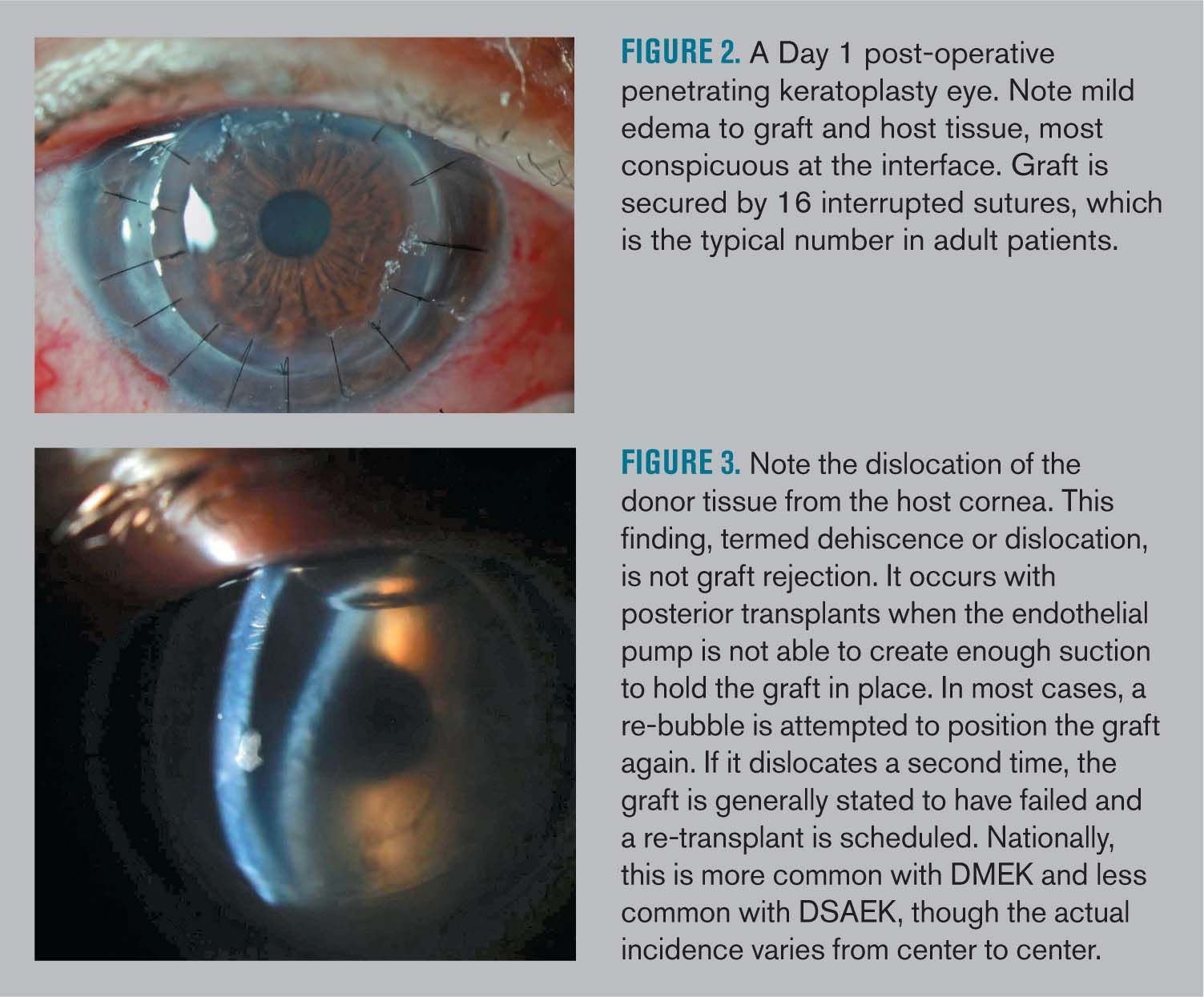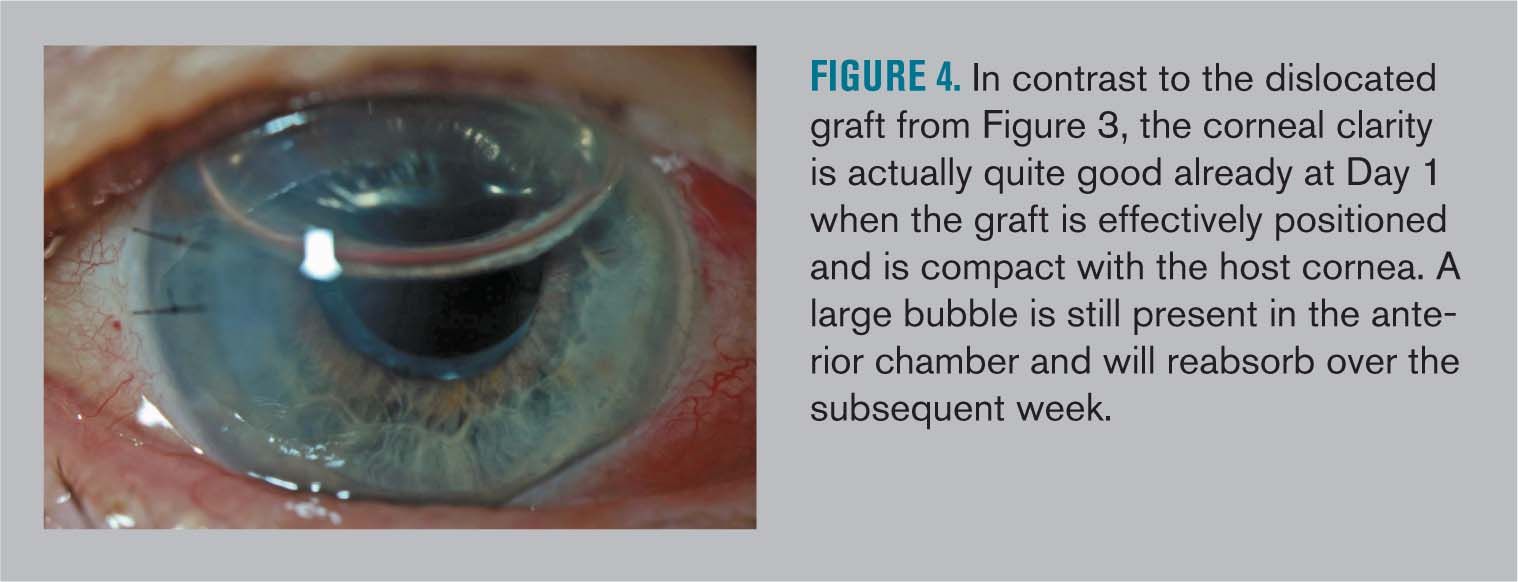Simplifying the corneal alphabet soup
When it comes to acronyms, there is no ophthalmic sub-specialty that compares to corneal surgical procedures. For example, let’s take a look at corneal transplants and therapeutic surface treatments. Among KLAL, DALK, PLK, LK, DLEK, DSEK, DSAEK, DMEK, and DMAEK, there is no wonder why there is so much confusion.


We are fortunate to practice optometry during an era of rapid growth and advancements in technology and surgical procedures. Every practitioner has been affected by MGD, DES, OCT, AREDS, or its less creatively-named younger sibling, AREDS 2. When it comes to acronyms, there is no ophthalmic sub-specialty that compares to corneal surgical procedures. For example, let’s take a look at corneal transplants and therapeutic surface treatments. Among KLAL, DALK, PLK, LK, DLEK, DSEK, DSAEK, DMEK, and DMAEK, there is no wonder why there is so much confusion. The purpose of this article is to briefly highlight the strengths and the weaknesses of each procedure in a way that will be straightforward but meaningful enough to be easily remembered. To keep things simple, it’s useful to subdivide the different corneal procedures into full-thickness transplants, anterior lamellar grafts/treatments, and posterior lamellar grafts.
Keratoconus: Cracking the corneal code
Full-thickness graft
There is only one full-thickness transplant technique, penetrating keratoplasty (PK). Prior to the lamellar grafts, PK was the oldest and most successful solid tissue transplant technique in medicine. PK is indicated for deep corneal scarring, keratoconus, endothelial pathology, perforations, and advanced corneal diseases. Contraindications to the procedure include glaucoma, vascularized corneas, and cases of previous graft failure. The procedure entails a full thickness removal of 7 mm to 9 mm of the central diseased cornea followed by suturing of healthy donor corneal tissue. Postoperatively, healing time may range from 18 to 24 months for full stabilization. Although PK has enjoyed a long and outstanding record of success, the development of other transplants options has reduced the amount of PK procedures performed. Due to PK’s disadvantages compared to the anterior and posterior lamellar grafts, PK has become a secondary option in most cases of corneal transplants, though will remain the only graft indication in 15 percent of cases. Reference it has become a secondary option at many surgical facilities, though due to its relative simplicity, it is used more widely than anterior lamellar alternatives.1
PK pros/cons
Pros:
• Easier to performGood optical results
• All corneal layers addressed
Cons:
• Risk of graft rejection
• Intraocular complications
• Risk of graft rupture
• Complications of chronic steroid use
• Prolonged visual outcome complicated by frequent need for rigid gas permeable contact lens use
• Eventual failure of the graft due to endothelial collapse, even in uneventful recoveries

Anterior lamellar graft
What looks like a PK, but sounds like a posterior lamellar graft? A DALK, of course. Deep anterior lamellar keratoplasty (DALK) is an alternative to PK for anterior indications of corneal transplant-namely scarring, stromal dystrophies, and corneal ectasias. Though DALK has been in evolution for decades, it remains a challenging and time-consuming surgery, often taking between one and three hours. The goal of DALK is to transplant all anterior corneal layers except the anterior to host Descemet’s membrane and endothelium. During the procedure, the donated epithelium is rapidly replaced with host tissue as a result of the limbal epithelial stem cells. By maintaining host endothelium, DALK grafts achieve their primary benefit over PK: eliminating risk of long-term graft rejection. Additionally, DALKs, which should persist indefinitely in uneventful courses, have a longer life expectancy than PKs. Finally, due to the reduced risk of rejection and subsequently lesser dependence on steroids, DALKs have a lower rate of severe glaucoma possibly requiring filtering surgery, microbial infection, herpetic recurrence within the graft, and cataract development.2
DALK pros/cons
Pros:
• Maintain host endothelium
• Reduced long-term risk of graft rejection
• Longer graft survival
• Reduced steroid related complications
Cons:
• Time-consuming surgery
• Risk of intraoperative perforation of Descemet’s membrane, leading to conversion to PK
• High incidence of irregular cylinder post operatively
• Similar refractive considerations as with PK (same as PK)
Worse outcome linked to newer corneal transplant techniques
Lamellar keratectomy (LK)
Unlike the other techniques described in this article, LK is not a transplant. It is, however, the appropriate alternative to transplants for diseases of the superficial cornea. Common indications include anterior basement membrane dystrophy, Salzmann’s nodular degeneration, band keratopathy, and recurrent corneal erosion (RCE). These conditions can interfere with both patient comfort and quality of vision and warrants LK. The procedure can be performed at the slit lamp or in the operating room, depending on surgeon preference. After topical anesthetics are instilled, sodium fluorescein is used to identify surface irregularities and “sick” epithelium. Using a dry cellulose sponge or a scarifier blade, the treatment is limited to the corneal epithelium, which is removed down to Bowman’s layer. Some surgeons utilize a diamond burr during the procedure to polish Bowman’s membrane. After removal, the clear corneal surface is polished with a cellulose sponge, topical antibiotics are administered, and a conventional bandage contact lens is placed to promote healing and patient comfort. Postoperatively, patients are treated and followed similarly to photorefractive keratectomy (PRK-yet another acronym). According to Soong et al, only six percent of their patients experience another RCE within two months.3
LK pros/cons
Pros:
• Improved quality of vision through both removal of superficial opacity as well as reduction in irregular astigmatism
• Stronger epithelial basement membrane attachment
Cons:
• Increased risk of infection
• Temporary discomfort

Posterior lamellar grafts
Posterior lamellar grafts have evolved over the past decade and represent one long continuum in a surgery’s maturation process. The most common indications for these procedures include Fuch’s endothelial dystrophy and pseudophakic bullous keratopathy (PBK). The first posterior lamellar graft introduced was Melles’s posterior lamellar keratoplasty (PLK).4 Several years later, Terry refined the procedure for utilization within the United States, naming it deep lamellar endothelial keratoplasty (DLEK).4 Both of these procedures were effective, but both required a posterior dissection of the host stroma, a maneuver that was so technically difficult that it stifled the procedures’ wider dissemination.
Melles’s answer to this was the technically simpler Descemet’s stripping endothelial keratoplasty (DSEK), the first posterior lamellar transplant to achieve widespread utilization.4 To take it a step further, the preparation of donor tissue was simplified further by Gorovoy’s use of the microkeratome, yielding Descemet’s stripping automated endothelial keratoplasty (DSAEK). Several years later, DSAEK remains the most commonly performed posterior technique in the United States.4 The tissue making up a DSAEK graft mainly includes Descemet’s membrane and endothelium, but a bit of posterior stroma is utilized. This stroma provides the benefit of insulating the endothelium during surgery from damage as well as enhancing the ease with which the graft can be inserted and positioned within the eye. One drawback of DSAEK is the mild degradation of the optical interface with the host, limiting postoperative vision in most cases to 20/30.5 Many patients within six months achieve best-corrected visual acuity up to 20/40.4
DSAEK pros/cons
Pros:
• No sutures
• Quicker visual recovery
• Less risk of rejection than PK
• Less risk of early and failure than DMEK
• Less intraoperative complications
Cons:
• Limited postoperative vision compared to DMEK
Although DSAEK gained in popularity, Melles pushed the development further to develop Descemet’s membrane endothelial keratoplasty (DMEK), the procedure that is less commonly performed today. DMEK grafts are comprised solely of Descemet’s membrane and endothelium, which provide tremendous optics and outcomes of 20/25 or even 20/20.6 Due to the elastic nature of this delicate tissue, DMEK transplants are more difficult to manipulate and carry a higher risk of early graft dislocation and failure if not properly performed. For these reasons, DMEK has not become as widely used asgained in utilization with corneal surgeons favoring DSAEK.7
DMEK pros/cons
Pros:
• Quicker visual acuity recovery
• Better quantity of vision
• Lower risk of rejection then even DSAEK
Cons:
• Higher risk of failure
• Fragile donor tissue
Regardless of the posterior graft used, all have some key benefits over PK. Primarily there is little or no change to the refraction and, subsequently, little to no dependence on rigid contact lenses for best vision. Further, there are no time-consuming attempts to modify astigmatism with suture adjustment or RGP lenses, and the recovery of vision is much more rapid due to less surgically induced astigmatism. Time until full recovery varies with DMEK recovery being achieved more rapidly than DSAEK, but useful vision is often in place by the end of the first month. Lastly, posterior lamellar grafts have a lower risk of rejection than PK. This has to do with the reduced level of inflammation, lack of substantial corneal neovascularization or lymphangiogenesis, and lack of sutures enjoyed by these grafts.

Miscellaneous grafts
Keratolimbal allograft (KLAL) is an infrequently encountered transplant, which involves donor limbal tissue. This procedure is indicated for cases of limbal stem cell failure as encountered with severe ocular surface disease as in Steven’s-Johnson syndrome, chemical burns, or keratopathy associated with aniridia. It is a technically difficult procedure, which which has a high risk for post-operative rejection, due to the fact that, unlike the central cornea, the limbus is not an immune privileged site like the central cornea. Because of this, the postoperative course, and requires a more vigorous systemic immune suppression, unlike the other corneal transplants.
Optometry’s role
While the similar-sounding acronyms littered across the field of corneal transplantation can seem daunting to understand, the main goal in corneal transplants/treatments is to preserve ocular tissue and improve the quality vision for our patients. With PK, DALK, LK, DSAEK, DMEK, and KLAL, patients and surgeons have numerous options for effective, targeted corneal transplantation than ever before. This allows for earlier intervention, less risk of complication, better graft survival and more years of useful vision. Additionally, many patients in need of these corneal procedures may also be candidates for combined cataract and corneal surgery. It’s just up to you to refer for the right acronym.
References
1. Eye Bank Association of American National Report 2012: http://www.restoresight.org/wp-content/uploads/2013/04/2012_Statistical_Report_FINAL-reduced-size-4-10.pdf. Accessed 11/17/2014. Accessed 11/17/2014.
2. Cheng YY, Visser N, Schouten JS, et al. Endothelial Cell Loss and Visual Outcome of Deep Anterior Lamellar Keratoplasty vs Penetrating Keratoplasty: A Randomized Multicenter Clinical Trial. Ophthalmology. 2011 Feb;118(2):302-9.
3. Soong HK, Farjo Q, Meyer RF, et al. Diamond burr superficial keratectomy for recurrent corneal erosions. Br J Ophthalmol. 2002 Mar;86(3):296–8.
4.Terry MA. Endothelial Keratoplasty: Why Aren’t We All Doing Descemet Membrane Endothelial Keratoplasty? Cornea. 2011 May;31(5):469-71.
5. Koenig SB, et al. Visual Acuity, Refractive Error and Endothelial Cell Density Six Months after Descemet Stripping and Automated Endothelial Keratoplasty (DSAEK). Cornea. 2007; Jul;26(6):670-4.
6. Price MO, Geibal AW, Fairchild KM, Price FW. Descemet’s Membrane Endothelial Keratoplasty. Ophthalmology. 2009; 116: 2361-2368
7. Patel SV. Graft survival and endothelial outcomes in the new era of endothelial keratoplasty. Exp Eye Res. 2012 Feb;95(1):40-7.
Newsletter
Want more insights like this? Subscribe to Optometry Times and get clinical pearls and practice tips delivered straight to your inbox.